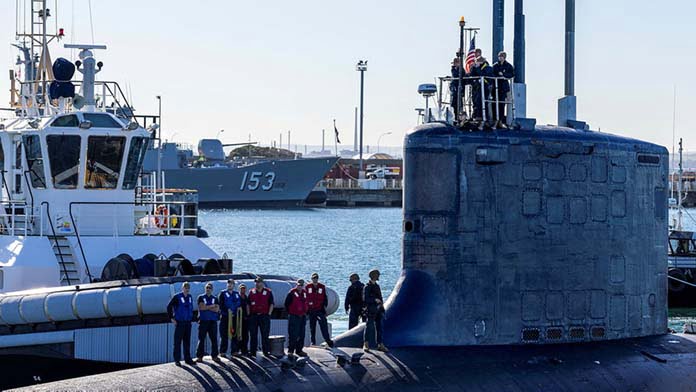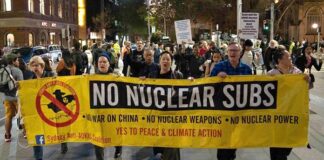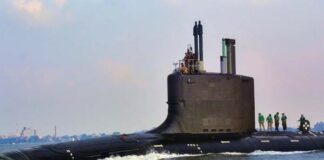There’s a persistent belief on the left that the Australian government was bulldozed into accepting the AUKUS nuclear submarine agreement in September 2021 by the White House and the Pentagon. According to this argument, Australia is little more than a puppet of the United States.
Nuked, a new book by former ABC reporter Andrew Fowler, blows this view out of the water. Fowler documents in meticulous detail the way in which Scott Morrison’s government campaigned to win US support for the project.
On 30 April 2021, there was a meeting in Washington DC between Australian spook-in-chief Andrew Shearer, Director-General of the Office of National Intelligence and a former National Security Adviser to two prime ministers, and Joe Biden’s US National Security Adviser Jake Sullivan and his offsider Kurt Campbell.
The Americans were told only that Shearer, who had to be operating with Morrison’s knowledge and support, wanted to discuss a matter “of the utmost sensitivity”.
At the meeting in the West Wing of the White House, Shearer, backed by Australian ambassador Arthur Sinodinos, former chief of staff with John Howard, asked the US for nuclear submarine technology.
Participants at the meeting say Shearer told Campbell, “As China’s capability advances, we need to have submarines capable of meeting it. We need to be able to operate without the risk of easy detection by the Chinese.”
The request didn’t come out of the blue. Fowler writes that the idea of obtaining nuclear subs had been kicked around between 2012 and 2015 but abandoned because Australia lacked nuclear skills.
In May 2020 Morrison ordered a feasibility study into how Australia could get nuclear submarines without an Australian nuclear industry to support them. He was told it was possible only with the cooperation of the US or Britain, or both.
Mixed response
The pitch to the White House received a mixed response. According to Nine newspapers’ Peter Hartcher, Biden was cautious, even sceptical. But Campbell later summed up the US position, saying, “What most countries do when grappling with relevance, when risks and costs are enormous, is they just opt out. Australia chose relevance.”
Why did the Morrison government chase nuclear subs? Fowler briefly alludes to what has been called Australia’s “fear of abandonment” but doesn’t flesh out the argument.
Australia is a sub-imperialist power—one that can dominate the immediate region but that has needed the support of first Britain and then the US to back it against more powerful rivals.
That support is not automatic. Three times, the US refused to support the Australian ruling class in disputes involving Indonesia.
Between 1964 and 1966, Australian troops fought to defend the newly independent state of Malaysia from Indonesia. But historian Hugh White wrote that the US, “would not assure Australia of military support against a disruptive and increasingly well-armed Indonesia”.
In 1969, the US supported Indonesia’s takeover of West Papua, which Australia had hoped to grab, given its shared border with PNG, then an Australian colony.
The pattern was repeated in 1999, when President Bill Clinton refused an Australian request for military support against Indonesia in East Timor/Timor Leste. Howard admitted to being “disappointed” and “stunned”.
US bombers
So successive governments, Liberal and Labor, have sought ways to bind the US tighter to Australia—volunteering to go to war in Vietnam, Iraq and Afghanistan, offering a base for US marines in Darwin and US bombers at RAAF Tindal, and allowing the US to run satellite stations in outback Australia.
Fowler provides a useful rundown of the role of these bases: Pine Gap near Alice Springs, the naval station at North West Cape and a third US base, the little known USAF-operated Joint Geological and Geophysical Research Station, which measures seismic activity to detect the use of nuclear weapons.
The book also includes a section on how the Liberals pushed for nuclear weapons and nuclear power in the years following the Second World War—long before Peter Dutton’s current proposal.
I certainly didn’t know, for example, that a private company, Silex, had been allowed to rent space at the Lucas Heights nuclear plant in Sydney to operate a uranium enrichment program using a revolutionary laser process, which led to a technology transfer agreement in 1999 with the US.
Ironically, however, despite having provided ample evidence that the Australian government prosecuted the argument for nuclear subs, Fowler falls back into the argument that Australia is surrendering its sovereignty to the US.
It’s a flawed position that opens the way for the likes of researchers Hugh White and Sam Roggeveen to argue that the answer is a more independent policy where Australia prioritises its own military build-up and sovereign weapons manufacturing capability.
Workers have no interest in the drive to war and we need to hold the warmongers in Canberra to account. Read carefully, Fowler’s book can give us some of the ammunition we need for the job.
By David Glanz
Nuked: The Submarine Fiasco that Sunk Australia’s Sovereignty
By Andrew Fowler, Melbourne University Press, 2024, $35






